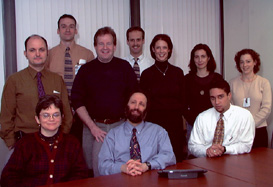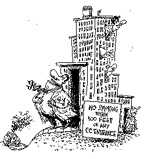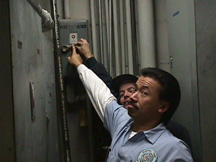Published monthly for CC employees by Clinical Center
Communications
March 1999
Learning from a distance
Laboratory system debuts
Working better
Noses for news
No Smoking policy
New fire alarm system
Children & healthcare
week
Dr. Cornman dies
Dig this
How low?
News briefs
|
|
 |
| The first class of the CC-Duke University Training Program in Clinical Research.
Seated (left to right) are Marjorie Garvey, Raphael Schiffmann, and Joshua
Kouri. Standing (left to right) are Gabor Illei, Joseph Hoxworth, Richard
Messman, Douglas Shaffer, Kara Sovik, Irini Sereti, and Susanne Goldstein.
Not pictured: Salman Azhar, Richard Nahin, Jorge Tavel, and George Wittenberg. |
Learning from a distance
It's late afternoon as students assemble in a sixth-floor conference
room. A television monitor displays students filling a classroom hundreds
of miles away, at Duke University in Durham, N.C. There, a professor steps
up to a lectern to begin the day's talk. Cameras and microphones in both
classrooms swing into action, enabling these distant groups to see and hear
one another with ease. Class is now in session.
Fourteen NIHers comprise the inaugural class of the CC-Duke Training
Program in Clinical Research. This spring, they will complete the first
of two years of course work done via videoconferencing.
"It's worked much better than I anticipated," NCI's Dr. Richard
Messman said of the long-distance learning. "The teachers are very
responsive to us, and the interaction is much as if we were right there
at Duke."
Designed primarily for clinical fellows and other health professionals
who are training for careers in clinical research, the program offers formal
courses in research design, statistical and decision analysis, research
ethics, and research management.
"The program is very practical," said Dr. Raphael Schiffmann
of NINDS. "I am the principal investigator on several different clinical
research protocols, so the courses are directly relevant to what I do."
Academic credit earned by participating in the program may be applied
toward satisfying the degree requirements for a Master of Health Sciences
in Clinical Research from Duke University School of Medicine. A non-degree
option is also offered. In addition to the videoconferenced classes from
Duke, some courses are held on-site by adjunct faculty. When class is not
in session, students can connect with Duke via fax, email, telephone, or
the internet.
Although students say the current setup works well, next year's sessions
should be even more effective, according to DeNedra Bluitt, CC coordinator.
"We plan to have a larger classroom and make some technological improvements
so our students feel even more a part of the Duke site," she said.
Applications for the 1999-2000 academic year are available from the NIH
Office of Education, Bldg. 10, Room 1C129. Enrollment is limited. The deadline
for receipt of applications is April 15. Accepted applicants will be notified
by July 1.
"It is a great opportunity," said Dr. Schiffmann, "and
very convenient to be able to attend classes right here at the Clinical
Center. I strongly recommend it for anyone with an interest in clinical
research."
The course web site at http://www.cc.nih.gov/ccc/cc_duke/info.html
has information regarding course work and tuition costs for the 1999-2000
academic year.
E-mail queries regarding the program may be addressed to Dr. William
E. Wilkinson, Program Director, at crtp@mc.duke.edu,
or call DeNedra Bluitt, CC coordinator, 6-9425.
index |
New Laboratory Information System debuts
The new Laboratory Information System (LIS) will debut on March 6, capping
over three years of work by a host of CC and contract staff. The LIS replaces
a system designed in the 1970s.
"The old system served us very well over all these years,"
said Peggy Spina, laboratory manager for Clinical Pathology, "but it
was time to upgrade it and make it Y2K compliant."
CC medical staff are familiar with the Medical Information System (MIS),
which is used to order tests and retrieve test results. The LIS is the laboratory
counterpart; it receives an order for a test from MIS, collects the test
result as it comes off the laboratory testing apparatus, and sends that
result back to MIS, where the physician can retrieve it. "The two systems
are constantly pitching and catching information," said Spina.
The LIS is a joint effort of Clinical Pathology, Transfusion Medicine,
and Anatomical Pathology (a component of NCI), Information Systems, and
the vendor, Soft Computer Consultants.
"A whole host of people have worked very hard on this new system,"
said Spina. "Everyone involved has done a tremendous job to make it
perform."
Staff had to design and "build" a software module for each
of the 1500-plus tests offered by the laboratories. "Red flags"
indicating abnormal lab values had to be programmed in for each test. "Every
one of the steps to make it work had to be thought out," said Spina.
The system will streamline the test order-and-retrieval process to improve
patient care, efficiency, and cost-effectiveness. A Blood Bank module is
next in line for implementation later this spring.
The new LIS has required changes to selected MIS ordering screens, but
for the most part few changes will be apparent to the MIS user. "The
screens are self-explanatory, and in many cases these changes have streamlined
the ordering process," said Dr. Stephen Rosenfeld, acting chief of
the Information Systems Department, which oversaw the implementation of
the project. MIS users should watch for a memorandum outlining specific
ordering-screen changes, he said.
Another change to expect is a reduction in paper printouts. Daily physician
summaries will no longer be automatically generated. Instead, look for one-month
reports, and six-month cumulative summaries, which are to be filed in the
patient's medical record. Users who need additional written reports can
print condensed reports from MIS. Consult the Clinical Pathology web site
(http://www.cc.nih.gov/cp/) for
instructions on how to generate condensed MIS laboratory reports.
Staff are in the final stages of extensive testing and verification of
the crossover of orders from MIS to LIS, and the return of lab results from
LIS to MIS. But, as with any major new change, problems may crop up. The
switchover will occur early on Saturday, March 6, to minimize the impact
of any downtime or delays in service. Troubleshooters will be available
by telephone (see sidebar).
Coming later this year is the Clinical Data Repository, which will receive
all current lab data from the LIS as well as all archived lab data. This
will enable physicians to access an enormous amount of laboratory data,
request different types of reports, and customize report delivery. Watch
CCNews for details.
Trouble-shooters
If you have any concerns about the transition to the new LIS, or experience
any difficulties with it, please contact any of the following people:
Anatomic Pathology and Cytology:
· Dr. David Kleiner, 4-2942
Clinical Pathology
· Kathy Roden, 2-0584
· Peggy Spina, 6-5668
· Dr. Thomas Fleisher, 6-5668
Transfusion Medicine
· Janet Browning, 6-4506
· Sherry Sheldon, 6-8335
Information Systems
· Melanie Retzke, 6-6576
· Dr. Stephen Rosenfeld, 6-7946
|
index
|
Working Better: Are you time-management challenged?
Ever had a day where you felt super productive? Your schedule with work,
family, and other priorities just seemed to flow. Then, BAM!...all urgencies
hit at once. Doing even simple tasks takes twice as long because you feel
overwhelmed.
If you are the type of person who often feels time-management challenged
without knowing what direction to take next, this article will provide you
with some fresh ideas to help you get your life back on track.
1. Be "Present Moment" Focused
It is easy to sink into your past or fly forward into your future, but
all you really have is right here and now. Stop and take a deep breath.
Try to get the positive thoughts rolling and you will be more productive.
I often read passages from "The Precious Present," by Spencer
Johnson, to remind me of these important truths. I encourage you to pick
up a copy if you find your mind scattered in the midst of daily "to
do" items.
2. Simplify Your Life
We make our lives too complicated. Why do we order too many magazines that
end up in a pile barely touched, let alone read? Why is it that we spend
so much time sorting and reading through junk mail? Why do we check e-mail
every half hour? Why do we worry about balancing the checkbook when we
can use on-line banking services to lighten the load? Why do we stress
ourselves out cleaning the house when we could hire a housekeeper once
a week? Simple changes can lead to more time-time you can spend focusing
on things that really matter.
3. Focus on "Like" Activities
In the midst of the daily shuffle, do you jump from one project to the
next, not really feeling like you are accomplishing much? Try scheduling
"like" activities into time slots. For example, correspondence
may require scheduling a specific time each day to read and write e-mails,
return phone calls, set up future meetings, and confirm appointments. Also,
it's important to take full advantage of the time of day when you have
the most energy. If that's in the morning, schedule high priority activities
during that time, then wait until the afternoon to do less important tasks.
4. Detach from Outcomes
Wouldn't it be nice if we could know all of the outcomes of our efforts
right now? Like knowing if our protocol was approved so we could begin
our research project? Yet we need to learn that everything has its own
timing. When we try to push, it often just comes back to us as worry and
stress. Resolve to do what you have control over one day at a time. It
will help prevent you from getting overwhelmed and enable you to reserve
important energy for more important tasks.
5. Say "No"
Creating healthy boundaries between you and the people in your life is
done by this simple, complete word. Always remember that people will waste
your time if you allow them. So stop feeling guilty about taking time to
nurture yourself. People often ask me how I have time to read. My response
is that it is a conscious choice on my part. Think about it: you bend over
backwards for everyone else, so why not spend some time for yourself?
6. Nurture Your Calling
Do something that brings meaning and fun into your life. Find work that
fully engages you so that time flows with effortless ease. That is when
you know you are following your calling. I believe that all of us know
what our calling is. Most of us, however, are afraid to embrace it because
of money or what other people might say. Serious illness or life setbacks
often cause us to re-examine how we're spending our time. I've known people
who, after a setback, suddenly change careers or take a vacation they've
always wanted. As a wise sage once said, "You have to risk your identity
for a bigger future than you're presently living."
7. Let Go
As Jim Valvano, the late coach of the North Carolina State University basketball
team, once remarked, "Every day you should take time to laugh, to
think, and to cry." Try to hold onto every situation in your life
like you hold onto a railing on a roller coaster. You find if you let go,
life can be a rush! Time is meant to be nurtured, enjoyed, and treasured.
You can stay healthy and happy in many ways by letting go of the unpredictables
in life.
--by Michael Scott
Michael Scott has contributed several articles to Clinical Center News.
He is a keynote presenter and author of the book and tape "Catch Your
Balance and Run," available at NIH R&W stores.
index
|
CCNews needs noses for news
Just a reminder that Clinical Center Communications and Clinical Center
News are located at 6100 Executive Boulevard, in Rockville.
Being off campus presents some logistical challenges to keeping up with
the ever-changing environment of the Clinical Center. We hope those of you
in the building will remember to send us your story ideas, news, and calendar
items. We can arrange for photography of most hospital events. If you are
an aspiring writer, submit a story and get a byline. Submissions are preferred
in Microsoft Word or in the body of an e-mail.
Your eyes, ears, and noses for news can help CCNews be as timely and
informative as possible.
index |
Reminder: No smoking near CC
 Now that the beautiful new south entry is open, staff
and visitors should remember not to smoke within 100 feet of it-or any other
entrance to the Clinical Center. Now that the beautiful new south entry is open, staff
and visitors should remember not to smoke within 100 feet of it-or any other
entrance to the Clinical Center.
Fumes from tobacco smoke are known to affect smokers and nonsmokers alike.
To help curb the associated risk of exposure to environmental tobacco smoke,
the NIH instituted a ban on the use of lighted tobacco products in various
locations, including NIH buildings both on and off campus, in government-owned
vehicles, near entrances and exits, and within designated "Smoke-Free
Zones."
Unique to the CC is a policy developed in accordance with the standards
of the Joint Commission on Accreditation of Healthcare Organizations, which
was revised by the Medical Executive Committee in 1997, and takes into account
not only the employees of the CC, but also its patients and visitors. Here,
the health risks of smoking are coupled with another known risk, deaths
due to fire. Findings reported by the National Fire Protection Association
showed that 75 percent of fire fatalities in health-care institutions occur
among patients using smoking materials.
Therefore, at the CC, smoking has been banned in all patient-care units,
and throughout the building, including all stairwells and parking garages.
Smoking is also prohibited within 100 feet of all entrances and in "Smoke-Free
Zones."
Employees who wish to stop smoking can call the NIH Employee Assistance
Program for information and referral at 6-3164.
index |

Mike Lanouette (back) and Raymond Lim-Sharpe flip the switch in the CC
Electric Shop to cut power to the 1950's-vintage fire alarm system. The
Electric Shop is responsible for maintaining the new, much improved system.
New fire alarm system up and running
You've probably heard that voice. "There is an emergency in your
area! Please evacuate!" Heads poke out into the halls; quizzical looks
are exchanged. Where's the fire? Chances are, there wasn't one. It was the
testing of the new facility-wide fire alarm system.
As of last month, CC occupants have a much improved level of fire (life)
safety because of the new system, which is the culmination of three years
of installation and testing by staff of the Fire Prevention Section and
the Division of Engineering Services.
"That was no small task, given that we had to individually test
more than 4,000 devices, such as smoke detectors, manual pull stations,
audiovisual alarms, and overhead speakers," said J.P. McCabe, chief
of the Fire Prevention Section, Emergency Management Branch, Division of
Public Safety.
The new fire alarm system does two important things:
1) It automatically instructs occupants on what to do in an emergency,
and
2) it tells the NIH Fire Department the exact location of the alarm and
type of device that initiated the alarm. McCabe said CC occupants will now
know when there is an emergency in their area. He also said the new fire
alarm system permits orderly evacuations of only those zones that are in
alarm and verbally instructs occupants to exit to a safe zone.
The state-of-the-art system can be activated by manual pull stations,
smoke detectors, and sprinkler system water flow switches. It even monitors
itself to make sure all its components are working. This means that the
system can't be taken out of service without a "trouble" signal
going to the NIH Fire Department. The Fire Department then calls the Electric
Shop to repair the system.
Now when you hear that voice, do what it says. For more information on
the new system and what to do in case of a fire, call the Fire Prevention
Section at 6-0487.
index |

CC Celebrates Children and Healthcare Week
The CC will celebrate the 20th annual observance of Children and Healthcare
Week, March 14-20. This year's theme is "Partners in Pediatric Pain
Management," to help focus attention on better management of the pain
that children can experience when receiving medical care.
The Clinical Center program will include a multidisciplinary pediatric
poster exhibit outside the special events office, Room 1C174, and other
events for our pediatric patients and their families.
This annual event is sponsored by the Association for the Care of Children's
Health and is provided by the CC Children and Healthcare Week Planning Committee.
Watch for details on fliers around the CC. For more information, call Kristin
Johnsen at 6-7704.
index |
Rehabilitation Medicine's Dr. Tillye Cornman dies
Dr. Tillye Cornman, 82, a physician with the Clinical Center's Rehabilitation
Medicine Department, died Feb. 2 of congestive heart failure.
Dr. Cornman was born in New Orleans. She trained as a nurse before earning
a medical degree at Louisiana State University in 1943. She completed an
internship at Metropolitan Hospital, and a residency at Bellevue Hospital
in New York City. She was listed in the second edition of "Who's Who
of American Women."
In 1951 at age 34, Dr. Cornman was working in private practice in New
Orleans when she was shot by a patient who was undergoing treatment for
mental illness. The attack left her paralyzed from the waist down. During
her rehabilitation, she developed an interest in physical medicine and rehabilitation.
She received training as a physiatrist, and subsequently joined the Clinical
Center's Rehabilitation Medicine Department in 1954. She was a diplomate
of the American Board of Physical Medicine and Rehabilitation and a member
of the American Academy of Neurology. Dr. Cornman retired in 1988, but served
as a consultant until 1996. She was a longtime resident of the NIH Apartment
House, until it was demolished last year.
Colleagues remember Dr. Cornman as a dedicated and caring member of the
staff. "Tillye was a staunch patient advocate," said Dr. Lynn
Gerber, chief of the Rehabilitation Medicine Department. "She was very
well liked and respected by her patients, who noticed that she was able
despite her own disability."
Dr. Cornman was also an advocate for causes she believed in. According
to her daughter, Joan Uhlig, in the 1960s she challenged a law stating that
people who lived on federal property could not vote, and she won before
the Supreme Court. When she attempted to see the Declaration of Independence
at the National Archives and found that the building was not wheelchair
accessible, she wrote a letter to then Attorney General Robert Kennedy,
and soon received a reply that a ramp had been installed.
Said Dr. Gerber, "I will remember Tillye for her spirit and her
commitment. If she felt something wasn't right, she'd try her best to change
it. She was a very effective person."
Dr. Cornman is survived by her daughter, five sisters, two grandchildren,
and a great-granddaughter.
A memorial service is scheduled for April 6, at 3:30 p.m., in the Chapel
on the 14th floor. All are welcome to attend.
index |
Dig this

No, an asteroid didn't land in the CC's front yard. It's just the excavation
for the new Mark O. Hatfield Clinical Research Center. Between 50 and 60
dump trucks make at least 10 trips each on a typical day. Each truck can
haul off about 12 cubic yards of dirt. That's about the size of a Priority
One shuttle van. Some 180,000 cubic yards of dirt eventually will be hauled
off, leaving a hole in the ground a quarter of a mile long and between 25
to 40 feet deep. The displaced dirt will cap a full landfill near Olney.
For construction updates, consult the web site (http://www.cc.nih.gov/ccc/waytogo/update1.html),
or look for "The Way to Go" fliers in displays throughout the
Clinical Center.
index |

Help the Clinical Center "lower the bar" on costs.
If your cost-saving idea is approved, YOU are eligible to receive 10
percent of the savings generated. See your supervisor for details and a
cost-savings proposal form.
News briefs
Construction Q&A
If you have questions about construction of the Mark O. Hatfield Clinical
Research Center, come to an information session on March 16 for some answers.
Project coordinators will be available in two shifts to talk informally
about the construction and the new building: 7:30-8:30 a.m. and 2:30-3:30
p.m.
The sessions will be at the Clinical Research Center exhibit on the Clinical
Center's first floor. It's across from the Admissions Desk and near the
now-closed north entrance.
Watch this web site (http://www.cc.nih.gov/ccc/waytogo/update1.html)
for CC construction news and information.
Identical twins
Normal, healthy, identical-twin pairs of any age, race, or sex are needed
for a study of the differences in the genotype and phenotype of their T
cell-receptor repertoire. This study will provide insight as to the reasons
for various T cell responses, given a particular HLA class I haplotype,
in relation to genetic and environmental factors. Participants should be
willing to undergo a thorough medical history, HLA testing, complete blood
count, and leukapheresis, and should be available for further questioning
about their medical history. Twin donors will be paid for their blood donations.
For more information, call the HLA Laboratory at 6-8852.
RoundTable
On Mar. 26, Clinical Center RoundTable presents Arthritis of Recent Onset:
Studies in Patho-genesis and Prognosis. Dr. John I. Gallin, CC director,
will moderate, and the panelists are Dr. Hani El-Gabalawy, NIAMS; Dr. Ralph
Schumacher, VA Medical Center, Philadelphia, PA; and Dr. Lynn Gerber, CC.
Interested parties can view the live broadcast in Lipsett Amphitheater from
noon to 1 p.m. CME credit is available.
Vaccine study
Normal volunteers who have been immunized with hepatitis B and other
vaccines are needed for a study of risk factors for adverse events to vaccines.
Enrollment consists of completion of a questionnaire and donation of a blood
sample through a local physician. For further information, please contact
Ejaz Shamim, M.D., Laboratory of Molecular and Developmental Immunology,
CBER, FDA, Bldg. 29B, Room 2G11, 301-827-0459; fax 301-827-0852; e-mail:
shamim@cber.fda.gov.
Alling memorial service planned
A memorial service in honor of the late Dr. David W. Alling, CC biostatistician,
is scheduled for Friday, April 16, at 3:30 p.m. in Lipsett Amphitheater.
Dr. Alling died in January of respiratory failure. His service to NIH spanned
40 years. Since 1996, the Clinical Center was fortunate to have Dr. Alling
as a special assistant for biostatistics. All are welcome to attend the
service. For more information, contact Dee Koziol, 6-2209.
index |
Editor: Sue Kendall
Clinical Center News, 6100 Executive Blvd., Suite 3C01,
MSC 7511, National Institutes of Health, Bethesda, MD 20892-7511. Tel: 301-496-2563.
Fax: 301-402-2984. Published monthly for CC employees by the Office of Clinical
Center Communications, Colleen Henrichsen, chief. News, article ideas, calendar
events, letters, and photographs are welcome. Deadline for submissions is
the second Monday of each month.
top | cc
home page | nih home page
| |
|

